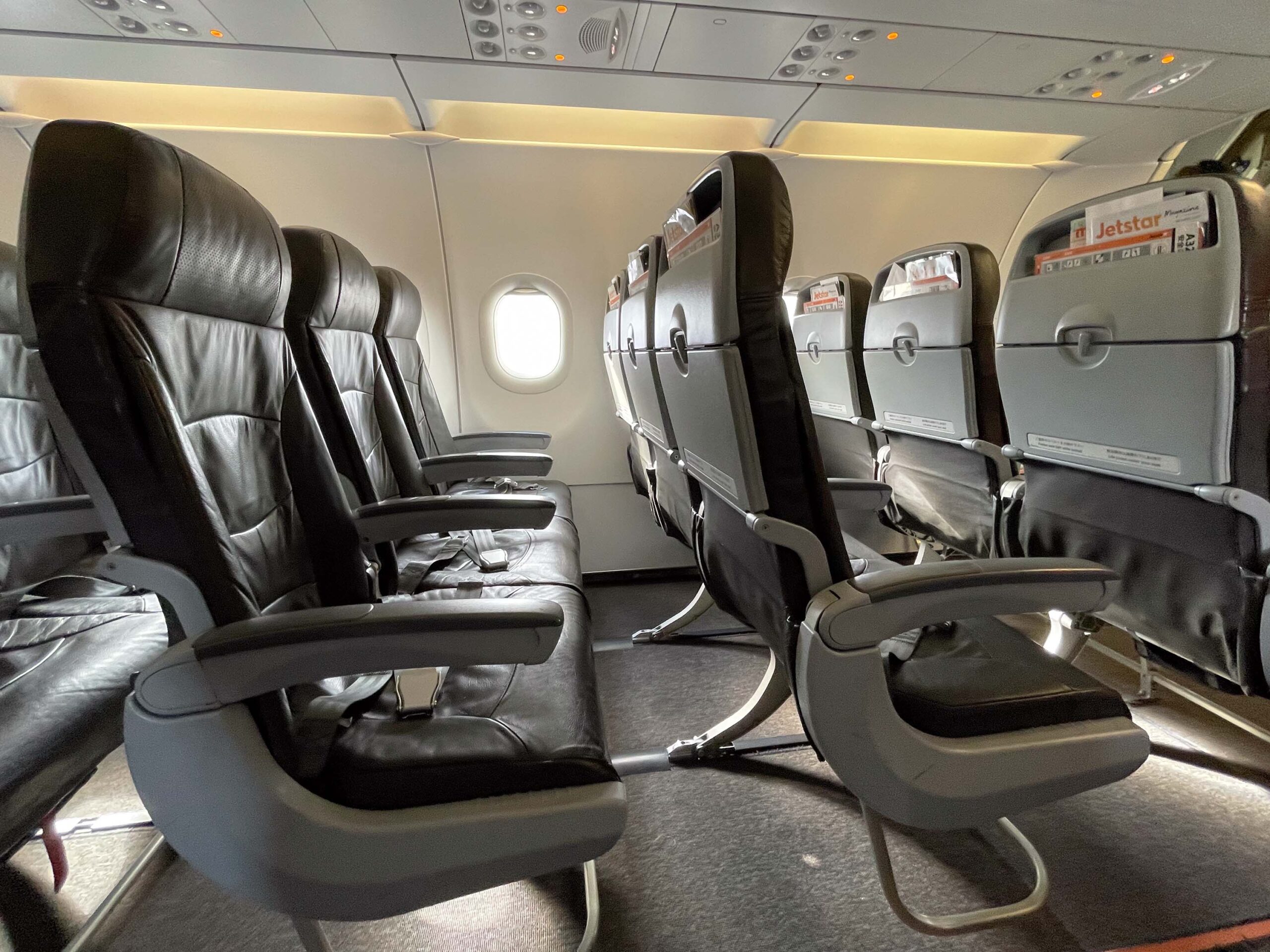
Jetstar Japan flight details
Airline : Jetstar Japan
Flight No : GK106
Departure City : Sapporo – New Chitose (CTS)
Arrival City : Tokyo – Narita (NRT)
Equipment : Airbus A320-200 (JA15JJ)
Blocked Time : 1h45m
Seat No: 3F
Jetstar Japan started operations in 2012 as a joint venture between Japan Airlines and Qantas. Based in Narita Airport near Tokyo, the airline focuses much of its operations on domestic flights within Japan. Many of its departures are timed for optimised connections to and from long-haul Jetstar flights from Australia. Like its sister airlines, Jetstar Australia and Jetstar Asia, the airline’s fleet is composed of A320-family aircraft; in Jetstar Japan’s case, this includes the A320-200 and the new A321LR.
Booking Jetstar Japan
I booked this ticket on the Jetstar official website, which is the shared booking platform across all of the airline’s multinational subsidiaries. In the end, I paid JPY 11,030 (~USD 75, GBP 60) for this one-way flight from Sapporo to Narita with an entry-level Starter fare. This includes an Upfront seat charge of JPY 950, as well as an annoying booking and service charge of JPY 640. I felt like this was on the high side for a flight on a low-cost carrier departing from Narita – especially when I paid just JPY 4000 more for a return on Japan Airlines several months earlier. I ultimately paid the price since this was a very last minute booking.
Check-in
After checking out of the Sapporo Grand Hotel, I headed to New Chitose Airport on the JR Chitose Line, which conveniently stops right under the domestic terminal. From the New Chitose Airport Station, I headed up two storeys in the direction of the South Wing Departures. From the Center Plaza, I turned right and kept walking, passing the counters of Japan Airlines, SkyMark Airlines, and Fuji Dream Airlines.


Along with Spring Airlines Japan, the Jetstar check-in counters are at the far end of the terminal, by Departure Gate F. There, the airline has a dedicated check-in area, complete with prominently displayed Jetstar branded check-in kiosks. While the automated kiosks can be used at any time, the counters will not accept check-in or bag drops until the indicated check-in time on the monitor. I did appreciate, however, that there is a weigh scale thoughtfully placed in front of the line.



Since I still had time, I ended up printing my boarding pass and bag tag with the kiosk. I later came back to the counters when they reopened, where a friendly Jetstar agent assisted in weighing and tagging my check-in bag. My carry-on was also tagged as a cabin bag but not weighed. Curiously, however, I had to get my bags have to be screened before they were accepted for check-in. This seems like a quirk of New Chitose Airport since I haven’t seen it at any other Japanese airports. Very interesting!


After dropping my bags, I headed straight to the nearby security checkpoint behind the Spring Airlines counters, which was a total breeze.
Boarding
After stocking my carry-on full of omiyage for friends back in Tokyo, I kind of stuck to sitting at the gate until boarding started. For one I was surprised by how comfortable the terminal seating is. That is until I saw that the chairs are manufactured by Poltrona Frau – the same Italian workshop that upholstered Singapore Airlines’ premium cabins. Wow!


About 15 minutes before the printed boarding time, the ground staff showed up and prepared the gate for the aircraft. By this time, they requested everyone whose carry-ons had not been checked to come forward and get them tagged. Unlike at check-in, each bag was weighed before being tagged. This certainly upset a few passengers who had to pay extra when their bags were found to be over the 7 kg limit.


At 11.42, two minutes after the printed boarding time, the gate agents started pre-boarding passengers with infants, pregnant passengers, and those requiring special assistance. Curiously, those seated in the extra legroom seats are also invited to board first. This was followed by general boarding at 11.50, by which time all other passengers were invited to board.


Today’s flight is operated by JA15JJ, an Airbus A320-200 delivered new to the airline in 2013. At the door, I was greeted by the friendly cabin crew, who welcomed me aboard this Jetstar flight.

Jetstar Japan A320 Cabin
Jetstar Japan A320s feature an all-Economy Class 3-3 configuration standard on any low-cost carrier. Unsurprisingly, the cabin is equipped with 180 seats as is common on many airlines. After all, this had been the maximum capacity of the A320ceo before it was increased to 186 in 2015. The grey leather seats themselves are actually pretty nice and well-maintained, however. Jetstar Japan uses the Collins Pinnacle seat, which you’ll also find on British Airways, Virgin Australia, and Batik Air, to name a few.



Curiously, the left-hand first row (seats 1A, 1B, and 1C) do not have a bulkhead separating it from the exit. As such, there is pretty much unlimited legroom in this row compared to the right-hand first row (seats 1D, 1E, and 1F). Notably, that makes these seats exit row seats, which disqualifies certain passengers from sitting there.


While the first five rows are sold as Upfront Seats, they do not feature a distinguishing feature or headrest. Yet, these seats are selected at a higher supplementary charge, with front-row seats going for JPY 1330 (~ USD 9, GBP 7) and rows 2-5 for JPY 950 (~ USD 6.5, GBP 5) in this sector. For reference, standard seats can be selected in advance from JPY 810 (~ USD 5.5, GBP 4), which is definitely on the higher side.



Seats on the Jetstar Japan A320
Despite the advertised seat pitch being 29 inches, I found the legroom onboard to be pretty good. At a height of 180 cm (5′ 11), there was a distance of 11 cm from my knee to seat back. This space is in part thanks to the clever strategy of moving the literature pocket to the top of the seat. This made the seats much better than those on AirAsia, which was a lot more restrictive.




In the seat pocket itself is the safety card, a complimentary inflight magazine, and an onboard menu catalogue. I’ll expand on the latter two in a bit. In addition, an airsickness bag was also provided, which isn’t a common sight on a lot of low-cost carriers.


I’ll note that the seats aren’t very well padded but they are ergonomic and comfortable enough for a sub-2 hour flight. In any case, these are much nicer than the slimline Recaro seats you’d find on the likes of TransNusa or the Lufthansa Group airlines. Finally, I’ll add that the tray table is sturdy, making it a good surface to use as a worktable. Overhead air vents are also installed, which I am personally thankful for.


Departure from Sapporo
As the boarding process went underway, I observed the purser and the flight attendants assisting elderly passengers in stowing their carry-on luggage. They didn’t even stop there and also organised the bags in the overhead lockers in anticipation of the other passengers. Wow, this is probably the best service I’ve seen on a low-cost carrier! Meanwhile, the two passengers seated in front were making a cacophony – the man played games with his phone on loudspeaker as his partner screamed into her phone. Thankfully, the purser respectfully requested them to keep their noise down.

The boarding door was closed at 12.05, by which time Purser Makiko made an announcement requesting that all phones be put in flight mode and seatbelts fastened. We started the pushback sequence three minutes later, at 12.08 – leaving two minutes before our scheduled time of departure. As we pushed back, a manual safety demonstration was conducted by Kurimu – the Russian-speaking flight attendant working the forward section.



After a very short taxi to the runway, we took off from runway 01L at 12.17. We did a 180-degree turn as we ascended to the skies, giving us a quickly diminishing view of the beautiful autumn foliage and New Chitose Airport from the skies.



Inflight service
About five minutes after takeoff, the seatbelt signs were turned off, prompting the crew to prepare for the paid refreshments service. As soon as the ding sounded, Purser Makiko announced in Japanese that the inflight service was about to commence. the cabin crew to start preparing for the onboard sales service.

As the cabin crew prepared for service, I consulted Jetstar Japan’s buy-on-board menu, Jetstar Café. Payments can be made via cash, Visa, Mastercard, or Jetstar vouchers. They have several combo deals going on, which makes the prices quite reasonable for paid refreshments. In terms of hot food, only instant ramen was available at roughly double the convenience store price. A few Jetstar-branded goods were also on sale, including a fleece blanket.


Since I wasn’t very hungry, I decided to pass on the inflight service and glued my eyes to the view outside the window instead. Instead, I sipped on the bottle of cold green tea I bought in the terminal, as I listened to music on my phone.


Inflight Entertainment
To Jetstar Japan’s credit, a complimentary inflight magazine is provided to every passenger. I was surprised to see that the airline explicitly encouraged passengers to take these magazines home. Better yet, the content was actually interesting and potentially useful! Instead of the normal corporate puffery you’d find in many inflight magazines, this one had a guide on the best gyoza shops in Miyazaki. Yum! There are also adorable safety illustrations featuring red pandas, which appear to be the airline’s mascot.





Lavatory
About midway into the flight, I quickly went to check out the forward lavatory. Jetstar Japan Airbus A320-200s are equipped with three lavatories, two of which are located at the rear of the cabin. Whilst standard-looking, I found the lavatory to be very clean and well-kept.


Service
Whilst I don’t usually have a service section for reviews on low-cost carriers, the service on this flight was just very good. While you’d expect the flight attendants to be friendly and professional, they also went above and beyond in assisting passengers. In addition to their great command of English, it felt nice to see them joyfully greeting passengers aboard the flight. I was more so touched seeing them patiently and happily assisting passengers requiring special assistance during boarding. Without a doubt, we had an exceptional crew!
Arrival in Narita
The captain greeted us 30 minutes into the flight and thanked us for flying Jetstar. He then announced our estimated time of arrival at 13.40 and that descent was about to start. As the crew wrapped up the inflight service, the seatbelt signs were lit – 28 minutes before our estimated time of arrival. The cabin crew then passed through the cabin to collect any garbage.

The noise from the preparations for landing must have woken up our loud buddy in front. As we descended, he proceeded to whip out his phone and watched Singles Inferno on loudspeaker for the rest of the cabin to hear. How thoughtful… 😉 Joking aside, we made a 90-degree turn over the Pacific Ocean on our approach. As we flew inland from the east, we got nice views of the rice fields and towns of Chiba and Ibaraki.


We had a very soft touchdown on Runway 34R of Narita International Airport at 13.41, arriving 14 minutes early. As we taxied to Terminal 3, Purser Makiko welcomed us to Tokyo Narita Airport and thanked us for choosing to fly with Jetstar.


We passed by Hotel Nikko Narita before we arrived at our stand at Terminal 3, the home of Jetstar Japan. There was also a Jetstar Boeing 787-8 at a remote stand, which flew in all the way from Australia. Once parked, we disembarked by stairs as is standard at Terminal 3. I thanked the crew and said goodbye as exited the aircraft.





Verdict
Overall, I was very satisfied with this flight on Jetstar Japan. While I had already known to expect a clean cabin and a relatively comfortable seat, it was the crew who truly made this flight excellent! If it weren’t for them, this would have been like an uneventful run-of-the-mill flight on any low-cost carrier. I can’t judge the airline based on one experience but even so, I’d fly Jetstar Japan again without thinking twice. I mean, there’s a reason why I’d rate Jetstar on a higher tier than AirAsia or Scoot.


Leave a Reply